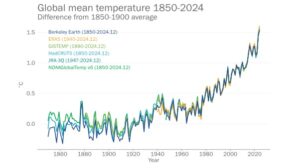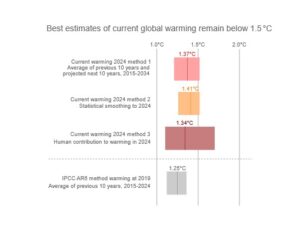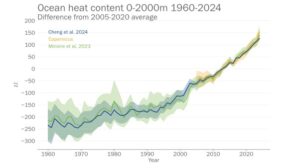The World Meteorological Organization (WMO) has launched its State of the Global Climate 2024 report, detailing the signs of human-induced climate change and the economic and social upheavals from extreme weather in 2024.
The State of the Global Climate report confirmed that 2024 was likely the first calendar year to be more than 1.5°C above the pre-industrial era, with a global mean near-surface temperature of 1.55 ± 0.13°C above the 1850-1900 average. This is the warmest year in the 175-year observational record.
António Guterres, Secretary-General of the United Nations, stated, “Our planet is issuing more distress signals – but this report shows that limiting long-term global temperature rise to 1.5°C is still possible. Leaders must step up to make it happen – seizing the benefits of cheap, clean renewables for their people and economies – with new national climate plans due this year.”
WMO Secretary-General Celeste Saulo confirmed, “While a single year above 1.5°C of warming does not indicate that the long-term temperature goals of the Paris Agreement are out of reach, it is a wake-up call that we are increasing the risks to our lives, economies and to the planet.”

The report says that long-term global warming is currently estimated to be between 1.34°C and 1.41°C compared to the 1850-1900 baseline based on a range of methods – although it notes the uncertainty ranges in global temperature statistics.
A WMO team of international experts is examining this further in order to ensure consistent, reliable tracking of long-term global temperature changes to be aligned with the Intergovernmental Panel on Climate Change (IPCC).
The record global temperatures seen in 2023 and broken in 2024 were found to be mainly due to the ongoing rise in greenhouse gas emissions, coupled with a shift from a cooling La Niña to warming El Niño event. Several other factors may have contributed to the unexpectedly unusual temperature jumps, including changes in the solar cycle, a massive volcanic eruption and a decrease in cooling aerosols, according to the report.
The bigger picture
“Data for 2024 show that our oceans continued to warm, and sea levels continued to rise. The frozen parts of Earth’s surface, known as the cryosphere, are melting at an alarming rate: glaciers continue to retreat, and Antarctic sea ice reached its second-lowest extent ever recorded. Meanwhile, extreme weather continues to have devastating consequences around the world,” said Saulo.
Tropical cyclones, floods, droughts and other hazards in 2024 led to the highest number of new displacements recorded for the past 16 years, contributed to worsening food crises and caused massive economic losses, the report says.
“In response, WMO and the global community are intensifying efforts to strengthen early warning systems and climate services to help decision-makers and society at large be more resilient to extreme weather and climate. We are making progress but need to go further and need to go faster. Only half of all countries worldwide have adequate early warning systems. This must change,” added Saulo, who said that investment in weather, water and climate services is more important than ever to meet the challenges and build safer, more resilient communities.
The report is based on scientific contributions from national meteorological and hydrological services, WMO Regional Climate Centres and UN partners. It includes sidebars on monitoring global temperature for the Paris Agreement and understanding the temperature anomalies in 2023 and 2024. It includes supplements on climate services and on extreme weather.

Atmospheric carbon dioxide
Atmospheric concentrations of carbon dioxide, as well as methane and nitrous oxide, were found to be at the highest levels for the last 800,000 years.
Carbon dioxide concentrations in 2023 (the last year for which consolidated global annual figures are available) were 420.0 ± 0.1 parts per million (ppm), 2.3ppm more than in 2022 and 151% of the pre-industrial level (in 1750); 420ppm corresponds to 3,276 Gt, or 3.276 trillion tonnes of CO₂ in the atmosphere.
Real-time data from specific locations showed that levels of these three main greenhouse gases continued to increase in 2024. Carbon dioxide remains in the atmosphere for generations, trapping heat.
Global mean near-surface temperature
In addition to 2024 setting a new record, each of the past 10 years, 2015-2024, were found to be individually the 10 warmest years on record. The record temperature in 2024 was boosted by a strong El Niño, which peaked at the start of the year. In every month between June 2023 and December 2024, monthly average global temperatures exceeded all monthly records prior to 2023. Record levels of greenhouse gases were the primary driver, with the shift to El Niño playing a lesser role.
Ocean heat content
The researchers found that, in 2024, ocean heat content reached its highest level in the 65-year observational record. Therefore, each of the past eight years has set a new record. The rate of ocean warming over the past two decades, 2005-2024, is more than twice that in the period 1960-2005. Furthermore, climate projections show that ocean warming will continue for at least the rest of the 21st century, even for low-carbon-emission scenarios.
Ocean acidification
Acidification of the ocean surface is continuing, as shown by the steady decrease of global average ocean surface pH. The most intense regional decreases were recorded in the Indian Ocean, the Southern Ocean, the eastern equatorial Pacific Ocean, the northern tropical Pacific, and some regions in the Atlantic Ocean.

Global mean sea level
In 2024, global mean sea level was the highest since the start of the satellite record in 1993 and the rate of increase from 2015-2024 was double that from 1993–2002, increasing from 2.1mm per year to 4.7mm per year.
Glacier mass balance
The period 2022-2024 represented the most negative three-year glacier mass balance on record. Overall, seven of the 10 most negative mass balance years since 1950 have occurred since 2016. Exceptionally negative mass balances were found in Norway, Sweden, Svalbard and the tropical Andes.
Sea-ice extent
The 18 lowest Arctic sea-ice minimum extents in the satellite record all occurred in the past 18 years. The annual minimum and maximum of Antarctic sea-ice extent were each the second lowest in the observed record from 1979.
The minimum daily extent of sea ice in the Arctic in 2024 was 4,280,000km2, the seventh lowest extent in the 46-year satellite record. In Antarctica, the minimum daily extent tied for the second lowest minimum in the satellite era and marked the third consecutive year that the minimum Antarctic sea-ice extent dropped below 2,000,000km2. These are the three lowest Antarctic ice minima in the satellite record.
Extreme events and impacts
According to the report, extreme weather events in 2024 led to the highest number of new annual displacements since 2008, and destroyed homes, critical infrastructure, forests, farmland and biodiversity. The compounded effect of various shocks, such as intensifying conflict, drought and high domestic food prices, drove worsening food crises in 18 countries globally by mid-2024. Tropical cyclones were responsible for many of the highest-impact events of 2024. These included Typhoon Yagi in Vietnam, the Philippines and southern China.
In the USA, Hurricanes Helene and Milton in October both made landfall on the west coast of Florida as major hurricanes, with economic losses of tens of billions of dollars. Over 200 deaths were associated with the exceptional rainfall and flooding from Helene, the most in a mainland USA hurricane since Katrina in 2005. Tropical Cyclone Chido caused casualties and economic losses in the French Indian Ocean islands of Mayotte, Mozambique and Malawi. It displaced around 100,000 people in Mozambique.
In related news, UNESCO and the World Meteorological Organization (WMO) recently launched the International Year of Glaciers’ Preservation, in an effort to protect the water towers that provide fresh water to over two billion people worldwide. Click here to read the full story.



